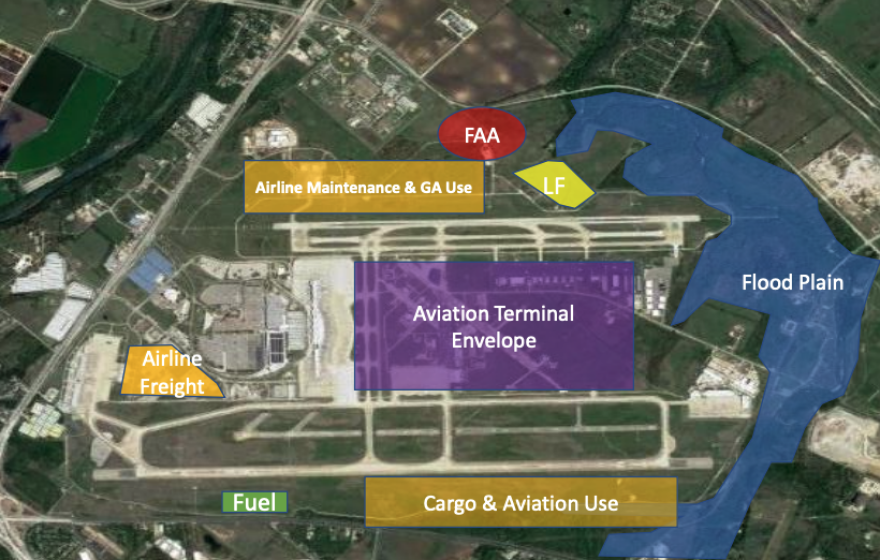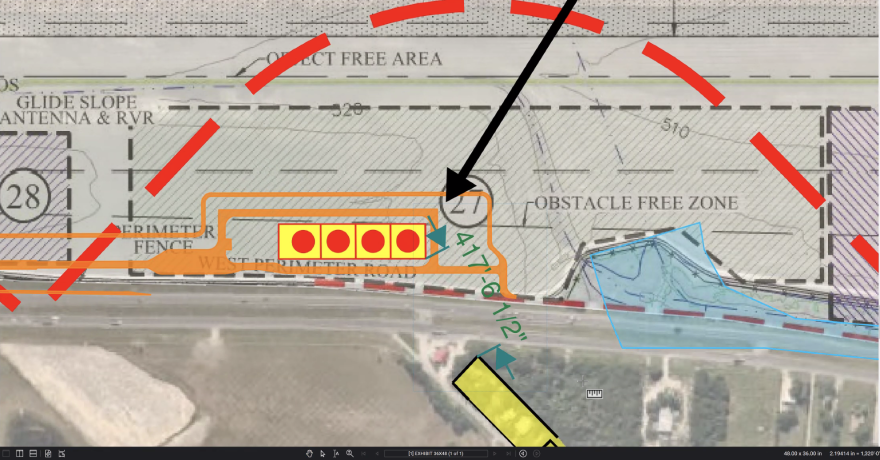From KUT:
Plans to store millions of gallons of jet fuel a few hundred feet from homes on McCall Lane is facing resistance from neighbors worried about their safety.
Officials with Austin-Bergstrom International Airport have said storing up to 6 million gallons of jet fuel poses virtually no risk to nearby residents, but the pushback prompted the City Council to order a fresh round of meetings with residents and an analysis of whether the facility could leak toxic fumes.

This illustration of the jet fuel tank farm shows two 1.5 million gallon storage tanks, but the site is being constructed to accomodate up to four such tanks.
Burns & McDonnell / City of Austin
We definitely want to be a good partner with our community and work with them,” said ABIA CEO Jacqueline Yaft, who’s among four finalists to lead Orlando International Airport and will be publicly interviewed next week. “We’re happy to answer any other questions or concerns.”
But some airport neighbors say they feel as if their concerns have been ignored and that getting certain information about the project has been difficult.
“Many of my neighbors are not aware of anything,” said Amanda Carrillo, a resident of McCall Lane who has been trying to raise awareness about the facility. “I feel like they’re taking advantage of us because they know that we’re minorities. We’re Spanish-speaking, and [my neighbors] don’t understand.”

Amanda Carrillo is trying to raise awareness among her neighbors about a plan for a jet fuel tank farm at the airport.
Patricia Lim / KUT
“What if it does explode? They say that it doesn’t. But what if it does?” she said.
Airport says more fuel storage is critical
The tank farm would initially have a pair of specialized 1.5 million gallon jet fuel storage tanks with room for two more 1.5 million gallon tanks.
The tanks would be filled by trucks that drive in jet fuel from a facility in Smithville. The fuel would be piped underground from the tank farm to a facility where trucks that refuel planes are replenished.
Long-term plans call for lines to go from the new facility directly to the Barbara Jordan Terminal, where each gate would be equipped with a hydrant to fuel planes.

The original design for the tank farm was modified to include a fence that would partially obscure a view of the facility. The change was made with the intention of accommodating neighbors, an airport spokesperson said.
Burns and McDonnell
/
City of Austin
The jet fuel tank farm is one of more than 60 projects that encompass a sweeping, multiyear expansion of Austin-Bergstrom International Airport based on a long-range plan approved by the Austin City Council.
Airport officials say the project is sorely needed. After an initial slump in air travel brought about by the pandemic, passenger growth has rebounded past 2019 levels. The airport recorded its busiest and second-busiest days ever last year. Officials expect the number of passengers and flights to double in 20 years.
“Most airports have five to seven days of fuel [stored],” Yaft said. “We have one to two.”
Airlines are concerned about the amount of fuel stored at ABIA, she said, especially given the airport’s growth trajectory. On busy days last year, at least three flights had to be diverted to refuel.

This map by airport officials illustrates where the fuel facility would be located. The map is rotated so that north is to the left and south is to the right.
City of Austin Department of Aviation
Airport staff provided a list of the storage facility’s safety features, including:
- 24/7 staffing and monitoring of the site
- a spill-containment structure around the tanks with a corrosion detection system to alert operators to leaks in real time
- fire-suppression systems inside each tank
- inspections every three months by firefighters stationed at the airport
- tanks that withstand outdoor heat and keep the fuel temperature-controlled
The project includes an $800,000 renovation of the intersection at U.S. 183 and Metropolis Drive where trucks would access the facility. Right now, 75 to 80 tanker trucks deliver fuel to the airport daily, with operations running almost around the clock.
The tank farm project has already obtained federal, state and local approvals including a finding from the Federal Aviation Administration that the project would have no significant impact on air quality or pose health and safety risks.
However, the FAA said in a statement that the agency has no regulations or guidance on how far a fuel farm should be from properties outside the airport’s perimeter.
Fewer than 500 feet away
Neighbors have been urging officials to consider locating the facility to another part of the airport’s 6.6-square-mile property.
The tank farthest south in the site plan would be fewer than 500 feet from the nearest residence, according to an analysis conducted by the local land-planning company Thrower Design. An airport spokesperson confirmed the distance was accurate.

Land planning company Thrower Design, hired by Howard Yancy, produced a site plan analysis showing the containment zone of the southern most storage tank would be about 417 feet from the nearest residential property.
Thrower Design
Thrower Design was hired by Howard Yancy, president of Zydeco Development, which owns the 550-acre MetCenter business park on Metropolis Drive. A yet-to-be developed tract of the business park is located directly across the highway from the proposed tank farm site.
“We can’t build office on the site, because you can’t lease office space where somebody’s overlooking a jet fuel tank farm,” Yancy said. “There have been problems with fuel tank farms. It may not be a high likelihood, but it’s still a significant risk.”
“Common sense tells you that when the Department of Aviation says there is no other place to put this jet fuel tank farm on a 7-square-mile piece of property, that just can’t be correct,” Yancy said.
Airport officials say they chose the site because it doesn’t conflict with future airport development and is ideal for installing underground transmission lines.
But residents who will sleep a few hundred feet from the tank farm are not comforted by the airport’s development plans.
“I really don’t want it to be there,” Carrillo said. “This is not good.”
City Council slows things down
In response to the outcry from neighbors, the Austin City Council in December ordered the city’s aviation department to conduct a fresh round of community meetings. The council also wants aviation staff to provide more information about potential air pollution the tank farm could generate.
“What is the risk exposure? What is being done to mitigate those risks? And should more be considered in having this fuel storage facility in that area?” said Austin City Council Member Vanessa Fuentes, whose district includes the airport and surrounding neighborhoods.
In compliance with the City Council’s resolution, airport officials have scheduled three community meetings on the tank farm for a single day at the end of the month.
The meetings are not a discussion of whether the project could be changed; they’re intended as informational meetings to answer resident questions. Those wishing to attend are asked to RSVP by calling 311 or emailing AirportEngagement@AustinTexas.gov.
Two in-person gatherings are planned on Saturday, Jan. 29, from 9:30 a.m. to 10:30 a.m. and 11 a.m. to noon. A virtual/call-in meeting is set for 3 p.m. to 4 p.m. Each meeting will have the same information, and Spanish interpretations will be provided.
Airport officials have until Feb. 7 to report back to the city council about how the community meetings went. A study on the air quality effects of the fuel storage is due by March 9.















